Spoke 15: The Biblewheel and The 15th Century
(Go back to main Menu)
The Stuart Bloodline of So Many James
The House of Stuart derives it's name from the position of stewardship. Since Abram's wife couldn't bear children, Abram requested God to give Eliezer of Damascus to inherit the land (which is an act of humbleness on Abram's part, along with Sarah, in the following chapter to give Abram her maid-servant) but God, honoring their marriage promised that Sarah would have a son despite their old age and he would inherit the land, which turned out to be Isaac.
The 15th book of the 3rd Cycle of the Biblewheel also known as the 15th Epistle is the Epistle of James.
The name "Stewart" derives from the political position of office similar to a governor, known as a steward. It was originally adopted as the family surname by Walter Stewart, 3rd High Steward of Scotland, who was the third member of the family to hold the position. Prior to this, family names were not used, but instead they had patronyms defined through the father; for example the first two High Stewards were known as FitzAlan and FitzWalter respectively. The gallicised spelling was first borne by John Stewart of Darnley after his time in the French wars. During the 16th century, the French spelling Stuartwas adopted by Mary, Queen of Scots, when she was living in France. She sanctioned the change to ensure the correct pronunciation of the Scotsversion of the name Stewart, because retaining the letter 'w' would have made it difficult for French speakers, who followed the Germans in usually rendering "w" as /v/. The spelling Stuart was also used by her second husband, Henry Stuart, Lord Darnley; he was the father of James VI and I, so the official spelling Stuart for the British royal family derives from him.
https://en.wikipedia.org/wiki/House_of_Stuart
-----
The sixth High Steward of Scotland, Walter Stewart (1293–1326), married Marjorie, daughter of Robert the Bruce, and also played an important part in the Battle of Bannockburn gaining further favour. Their son Robert was heir to the House of Bruce, the Lordship of Cunningham and the Bruce lands of Bourtreehill; he eventually inherited the Scottish throne when his uncle David II died childless in 1371.
The 15th book of the 3rd Cycle of the Biblewheel is the Epistle of James. And the monarchs of the 15th century Scotland are mostly named James. But notice the number of King James who ruled Scotland. It spans from 1406-1685 with the exception of Mary, queen of the Scots. But it does cover the 15th century.
Monarchs of Great Britain and Ireland
Following James II of England, despite the fact that it goes beyond the 15th Century, it seems like this lineage is branded with the name James and it's followers, the Jacobites:
https://en.wikipedia.org/wiki/James_II_of_England
(Go back to main Menu)
The Stuart Bloodline of So Many James
The House of Stuart derives it's name from the position of stewardship. Since Abram's wife couldn't bear children, Abram requested God to give Eliezer of Damascus to inherit the land (which is an act of humbleness on Abram's part, along with Sarah, in the following chapter to give Abram her maid-servant) but God, honoring their marriage promised that Sarah would have a son despite their old age and he would inherit the land, which turned out to be Isaac.
The 15th book of the 3rd Cycle of the Biblewheel also known as the 15th Epistle is the Epistle of James.
And if the battle of Bannockburn involved the Knights Templars in 1314 it would show that their last Grand Master in France was Jacques DeMolay who was executed.
Etymology
The name "Stewart" derives from the political position of office similar to a governor, known as a steward. It was originally adopted as the family surname by Walter Stewart, 3rd High Steward of Scotland, who was the third member of the family to hold the position. Prior to this, family names were not used, but instead they had patronyms defined through the father; for example the first two High Stewards were known as FitzAlan and FitzWalter respectively. The gallicised spelling was first borne by John Stewart of Darnley after his time in the French wars. During the 16th century, the French spelling Stuartwas adopted by Mary, Queen of Scots, when she was living in France. She sanctioned the change to ensure the correct pronunciation of the Scotsversion of the name Stewart, because retaining the letter 'w' would have made it difficult for French speakers, who followed the Germans in usually rendering "w" as /v/. The spelling Stuart was also used by her second husband, Henry Stuart, Lord Darnley; he was the father of James VI and I, so the official spelling Stuart for the British royal family derives from him.
https://en.wikipedia.org/wiki/House_of_Stuart
-----
More on the Stuarts:
House of Stuart
(Redirected from House of Stewart)
Stuart
Stewart
| |
|---|---|
|
Coat of arms of the last Stuart monarch Anne, Queen of Great Britain, 1707–1714
| |
Parent family
| |
Country
| |
Ethnicity
| |
Founded
|
1371
|
Founder
|
Robert II of Scotland (1316–1390)
|
Final ruler
|
Anne, Queen of Great Britain(1665–1714)
|
Titles
| |
Dissolution
|
1807
|
Cadet branches
| |
The House of Stuart, originally Stewart, was a European royal house that originated in Scotland. The dynasty's patrilineal Breton ancestors had held the office of High Steward of Scotland since the 12th century, after arriving by way of Norman England. The royal Stewart line was founded by Robert II, and they were Kings and Queens of Scots from the late 14th century until the union with England in 1707. Mary, Queen of Scots, was brought up in France, where she adopted the French spelling of the name, Stuart. Her son, James VI of Scotland, inherited the thrones of England and Ireland upon the death of Elizabeth I in 1603. Except for the period of the Commonwealth, 1649–1660, the Stuarts were monarchs of the British Isles and its growing empire, until the death of Queen Anne in 1714.[note 3]
In total, nine Stewart/Stuart monarchs ruled Scotland alone from 1371 until 1603. James VI of Scotland then inherited the realms of Elizabeth I of England, becoming James I of England and Ireland in the Union of the Crowns. Following the Glorious Revolution in 1688, two Stuart queens ruled the isles: Mary II and Anne. Both were the Protestant daughters of James VII and II by his first wife. Their father had converted to Catholicism and his new wife gave birth to a son in 1688, who would be brought up a Roman Catholic and would precede his half-sisters; so James was deposed by Parliament in 1689, in favour of his daughters. But neither had any children who survived to adulthood, so under the terms of the Act of Settlement 1701 and the Act of Security 1704, the crown passed to the House of Hanover on the death of Queen Anne in 1714.
During the reign of the Stuarts, Scotland developed from a relatively poor and feudal country into a prosperous, modern and centralised state.[clarification needed] They ruled during the transitive period in European history between the Middle Ages, via the Renaissance, to the midpoint of the Early modern period. Monarchs such as James IV were known for sponsoring exponents of the Northern Renaissancesuch as the poet Robert Henryson, among others. After the Stuarts reigned over all of Great Britain, the arts and sciences continued to develop; William Shakespeare wrote many of his best known plays during the Jacobean era, while institutions such as the Royal Society and the Royal Mail were established during the reign of Charles II.
...
History
The sixth High Steward of Scotland, Walter Stewart (1293–1326), married Marjorie, daughter of Robert the Bruce, and also played an important part in the Battle of Bannockburn gaining further favour. Their son Robert was heir to the House of Bruce, the Lordship of Cunningham and the Bruce lands of Bourtreehill; he eventually inherited the Scottish throne when his uncle David II died childless in 1371.
...
-----
Just as Abram was childless in Genesis 15 so was David II before the rise of the House of Stuart to the throne:
David II of Scotland
David II
| |
|---|---|
|
Later depiction of David II, by Sylvester Harding (published in 1797) —[1]
| |
Reign
|
7 June 1329 – 22 February 1371
|
24 November 1331
| |
Predecessor
| |
Successor
| |
Born
|
5 March 1324
|
Died
|
22 February 1371 (aged 46)
|
Burial
| |
Spouse
| |
Father
| |
Mother
| |
David II (Medieval Gaelic: Daibhidh a Briuis, Modern Gaelic: Dàibhidh Bruis; Norman French: Dauid de Brus, Early Scots: Dauid Brus; 5 March 1324 – 22 February 1371) was King of Scots for over 41 years, from 1329 until his death in 1371. He was the last male of the House of Bruce. Although David spent long periods in exile or captivity, he managed to resist English attempts to annex his kingdom, and left the monarchy in a strong position.
Early life
David II was the elder and only surviving son of Robert I of Scotland and his second wife, Elizabeth de Burgh. He was born on 5 March 1324 at Dunfermline Abbey, Fife. His mother died in 1327, when he was 3 years old.[2] In accordance with the Treaty of Northampton's terms,[3] On 17 July 1328, when he was 4, David was married to 7 year old Joan of the Tower, at Berwick-upon-Tweed. She was the daughter of Edward II of England and Isabella of France. They had no issue.[2]
-----
List of monarchs
Monarchs of Scotland
Monarchs of Great Britain and Ireland
Portrait
|
Name
|
From
|
Until
|
Relationship with predecessor
|
|---|---|---|---|---|
22 February 1371
|
19 April 1390
|
nephew[7] of David II who died without issue. Robert's mother Marjorie Bruce was daughter of Robert I.
| ||
19 April 1390
|
4 April 1406
|
son of Robert II of Scotland.
| ||
4 April 1406
|
21 February 1437
|
son of Robert III of Scotland.
| ||
21 February 1437
|
3 August 1460
|
son of James I of Scotland.
| ||
3 August 1460
|
11 June 1488
|
son of James II of Scotland.
| ||
11 June 1488
|
9 September 1513
|
son of James III of Scotland.
| ||
9 September 1513
|
14 December 1542
|
son of James IV of Scotland.
| ||
14 December 1542
|
24 July 1567
|
daughter of James V of Scotland.
| ||
24 July 1567
|
27 March 1625
|
son of Mary, Queen of Scots.
|
Portrait
|
Name
|
From
|
Until
|
Relationship with predecessor
|
|---|---|---|---|---|
24 March 1603
|
27 March 1625
|
Great-Great grandson of Henry VII of England. King of Scotland alone until inheriting the titles King of England and Ireland, including claim to France from the extinct Tudors.
| ||
27 March 1625
|
30 January 1649 (executed)
|
son of James VI and I
| ||
30 January 1649 (de jure); 2 May 1660 (de facto)
|
6 February 1685
|
son of Charles I. Prohibited by Parliament from assuming the throne during a republican period of government known as the Commonwealth of England, but then accepted as king in 1661.
| ||
6 February 1685
|
11 December 1688
|
brother of Charles II, who died without legitimate issue. Son of Charles I. Overthrown at the Revolution of 1688. Died in 1701.
| ||
13 February 1689
|
28 December 1694
|
daughter of James II & VII, who was still alive and pretending to the throne. Co-monarch was William III & II who outlived his wife.
| ||
8 March 1702
|
1 August 1714
|
sister of Mary II. daughter of James II & VII. Name of state changed to Great Britain with the political Acts of Union 1707, though family has used title since James I & VI. Died childless, rights pass to House of Hanover.
|
These monarchs used the title "King/Queen of Great Britain", although that title had no basis in law until the Acts of Union 1707 came into effect on 1 May 1707. Legally, they each simultaneously occupied two thrones, as "King/Queen of England" and "King/Queen of Scotland".
| Comparing Genesis 15 with the 15th Century | |
|---|---|
| Genesis 15 - Listen 1 After these things the word of the LORD came unto Abram in a vision, saying, Fear not, Abram: I [am] thy shield, [and] thy exceeding great reward. 2 And Abram said, Lord GOD, what wilt thou give me, seeing I go childless, and the steward of my house [is] this Eliezer of Damascus? 3 And Abram said, Behold, to me thou hast given no seed: and, lo, one born in my house is mine heir. 4 And, behold, the word of the LORD [came] unto him, saying, This shall not be thine heir; but he that shall come forth out of thine own bowels shall be thine heir. 5 And he brought him forth abroad, and said, Look now toward heaven, and tell the stars, if thou be able to number them: and he said unto him, So shall thy seed be. 6 And he believed in the LORD; and he counted it to him for righteousness. 7 And he said unto him, I [am] the LORD that brought thee out of Ur of the Chaldees, to give thee this land to inherit it. 8 And he said, Lord GOD, whereby shall I know that I shall inherit it? 9 And he said unto him, Take me an heifer of three years old, and a she goat of three years old, and a ram of three years old, and a turtledove, and a young pigeon. 10 And he took unto him all these, and divided them in the midst, and laid each piece one against another: but the birds divided he not. 11 And when the fowls came down upon the carcases, Abram drove them away. 12 And when the sun was going down, a deep sleep fell upon Abram; and, lo, an horror of great darkness fell upon him. 13 And he said unto Abram, Know of a surety that thy seed shall be a stranger in a land [that is] not theirs, and shall serve them; and they shall afflict them four hundred years; 14 And also that nation, whom they shall serve, will I judge: and afterward shall they come out with great substance. 15 And thou shalt go to thy fathers in peace; thou shalt be buried in a good old age. 16 But in the fourth generation they shall come hither again: for the iniquity of the Amorites [is] not yet full. 17 And it came to pass, that, when the sun went down, and it was dark, behold a smoking furnace, and a burning lamp that passed between those pieces. 18 In the same day the LORD made a covenant with Abram, saying, Unto thy seed have I given this land, from the river of Egypt unto the great river, the river Euphrates: 19 The Kenites, and the Kenizzites, and the Kadmonites, 20 And the Hittites, and the Perizzites, and the Rephaims, 21 And the Amorites, and the Canaanites, and the Girgashites, and the Jebusites. | |
| Comparing The 15th Epistle James with the 15th Century | |
|---|---|
| James 1 - Listen 1 James, a servant of God and of the Lord Jesus Christ, to the twelve tribes which are scattered abroad, greeting. 2 My brethren, count it all joy when ye fall into divers temptations; 3 Knowing [this], that the trying of your faith worketh patience. 4 But let patience have [her] perfect work, that ye may be perfect and entire, wanting nothing. 5 If any of you lack wisdom, let him ask of God, that giveth to all [men] liberally, and upbraideth not; and it shall be given him. 6 But let him ask in faith, nothing wavering. For he that wavereth is like a wave of the sea driven with the wind and tossed. 7 For let not that man think that he shall receive any thing of the Lord. 8 A double minded man [is] unstable in all his ways. 9 Let the brother of low degree rejoice in that he is exalted: 10 But the rich, in that he is made low: because as the flower of the grass he shall pass away. 11 For the sun is no sooner risen with a burning heat, but it withereth the grass, and the flower thereof falleth, and the grace of the fashion of it perisheth: so also shall the rich man fade away in his ways. 12 Blessed [is] the man that endureth temptation: for when he is tried, he shall receive the crown of life, which the Lord hath promised to them that love him. 13 Let no man say when he is tempted, I am tempted of God: for God cannot be tempted with evil, neither tempteth he any man: 14 But every man is tempted, when he is drawn away of his own lust, and enticed. 15 Then when lust hath conceived, it bringeth forth sin: and sin, when it is finished, bringeth forth death. 16 Do not err, my beloved brethren. 17 Every good gift and every perfect gift is from above, and cometh down from the Father of lights, with whom is no variableness, neither shadow of turning. 18 Of his own will begat he us with the word of truth, that we should be a kind of firstfruits of his creatures. 19 Wherefore, my beloved brethren, let every man be swift to hear, slow to speak, slow to wrath: 20 For the wrath of man worketh not the righteousness of God. 21 Wherefore lay apart all filthiness and superfluity of naughtiness, and receive with meekness the engrafted word, which is able to save your souls. 22 But be ye doers of the word, and not hearers only, deceiving your own selves. 23 For if any be a hearer of the word, and not a doer, he is like unto a man beholding his natural face in a glass: 24 For he beholdeth himself, and goeth his way, and straightway forgetteth what manner of man he was. 25 But whoso looketh into the perfect law of liberty, and continueth [therein], he being not a forgetful hearer, but a doer of the work, this man shall be blessed in his deed. 26 If any man among you seem to be religious, and bridleth not his tongue, but deceiveth his own heart, this man's religion [is] vain. 27 Pure religion and undefiled before God and the Father is this, To visit the fatherless and widows in their affliction, [and] to keep himself unspotted from the world. | |
Following James II of England, despite the fact that it goes beyond the 15th Century, it seems like this lineage is branded with the name James and it's followers, the Jacobites:
James II of England
| James II and VII | |
|---|---|

Portrait by Peter Lely
| |
| King of England, Scotland and Ireland(more...) | |
| Reign | 6 February 1685 – 11 December 1688 |
| Coronation | 23 April 1685 |
| Predecessor | Charles II |
| Successors | William III & II and Mary II |
| Born | 14 October 1633 (N.S.: 24 October 1633) St. James's Palace, London |
| Died | 16 September 1701 (aged 67)[1](N.S.) Château de Saint-Germain-en-Laye, France |
| Burial | Church of the English Benedictines, Paris[2] |
| Spouse |
|
| Issue more... | |
| House | Stuart |
| Father | Charles I of England |
| Mother | Henrietta Maria of France |
| Religion |
|
| Signature |  |
James II and VII (14 October 1633O.S. – 16 September 1701[1]) was King of England and Ireland as James II and King of Scotland as James VII,[3] from 6 February 1685 until he was deposed in the Glorious Revolution of 1688. He was the last Roman Catholic monarch of England, Scotland and Ireland.
The second surviving son of Charles I, he ascended the throne upon the death of his brother, Charles II. Members of Britain's Protestant political elite increasingly suspected him of being pro-French and pro-Catholic and of having designs on becoming an absolute monarch. When he produced a Catholic heir, a son called James, leading nobles called on his Protestant son-in-law and nephew William III of Orange to land an invasion army from the Dutch Republic, which he did in the Glorious Revolution of 1688. James fled England (and thus was held to have abdicated).[4] He was replaced by his Protestant eldest daughter Mary II and her husband William III. James made one serious attempt to recover his crowns from William and Mary when he landed in Ireland in 1689. After the defeat of the Jacobite forces by the Williamites at the Battle of the Boyne in July 1690, James returned to France. He lived out the rest of his life as a pretender at a court sponsored by his cousin and ally, King Louis XIV.
James is best known for his struggles with the English Parliament and his attempts to create religious liberty for English Roman Catholics and Protestant nonconformists, against the wishes of the Anglican establishment. This tension made James's four-year reign a struggle for supremacy between Parliament and the Crown, resulting in his deposition, the passage of the Bill of Rights, and the accession of his daughter and her husband as queen and king.
Early life
Birth
James, the second surviving son of King Charles I and his wife, Henrietta Maria of France, was born at St. James's Palace in London on 14 October 1633.[5] Later that same year, he was baptised by William Laud, the Anglican Archbishop of Canterbury.[6] He was educated by private tutors, along with his brother, the future King Charles II, and the two sons of the Duke of Buckingham, George and Francis Villiers.[7] At the age of three, James was appointed Lord High Admiral; the position was initially honorary, but would become a substantive office after the Restoration, when James was an adult.[8]
He was designated Duke of York at birth,[9] invested with the Order of the Garter in 1642,[10] and formally created Duke of York in January 1644.[6][9]
Civil War
The King's disputes with the English Parliament grew into the English Civil War. James accompanied his father at the Battle of Edgehill, where he narrowly escaped capture by the Parliamentary army.[11] He subsequently stayed in Oxford, the chief Royalist stronghold,[12] where he was made a M.A. by the University on 1 November 1642 and served as colonel of a volunteer regiment of foot.[13] When the city surrendered after the siege of Oxford in 1646, Parliamentary leaders ordered the Duke of York to be confined in St. James's Palace.[14] Disguised as a woman,[15] he escaped from the Palace in 1648 with the help of Joseph Bampfield, and crossed the North Sea to The Hague.[16]
When Charles I was executed by the rebels in 1649, monarchists proclaimed James's older brother king as Charles II of England.[17] Charles II was recognised as king by the Parliament of Scotland and the Parliament of Ireland, and was crowned King of Scotland at Scone in 1651. Although he was proclaimed King in Jersey, Charles was unable to secure the crown of England and consequently fled to France and exile.[17]
Exile in France
Like his brother, James sought refuge in France, serving in the French army under Turenne against the Fronde, and later against their Spanish allies.[18] In the French army James had his first true experience of battle where, according to one observer, he "ventures himself and chargeth gallantly where anything is to be done".[18] Turenne's favour led to James being given command of a captured Irish regiment in December 1652, and being appointed Lieutenant-General in 1654.[15]
In the meantime, Charles was attempting to reclaim his throne, but France, although hosting the exiles, had allied itself with Oliver Cromwell. In 1656, Charles turned instead to Spain – an enemy of France – for support, and an alliance was made. In consequence, James was expelled from France and forced to leave Turenne's army.[19] James quarrelled with his brother over the diplomatic choice of Spain over France. Exiled and poor, there was little that either Charles or James could do about the wider political situation, and James ultimately travelled to Bruges and (along with his younger brother, Henry) joined the Spanish army under Louis, Prince of Condé in Flanders, where he was given command as Captain-General of six regiments of British volunteers[15] and fought against his former French comrades at the Battle of the Dunes.[20]
During his service in the Spanish army, James became friendly with two Irish Catholic brothers in the Royalist entourage, Peter and Richard Talbot, and became somewhat estranged from his brother's Anglican advisers.[21] In 1659, the French and Spanish made peace. James, doubtful of his brother's chances of regaining the throne, considered taking a Spanish offer to be an admiral in their navy.[22] Ultimately, he declined the position; by the next year the situation in England had changed, and Charles II was proclaimed King.[23]
Restoration
First marriage
After Richard Cromwell's resignation as Lord Protector in 1659 and the subsequent collapse of the Commonwealth in 1660, Charles II was restored to the English throne. Although James was the heir presumptive, it seemed unlikely that he would inherit the Crown, as Charles was still a young man capable of fathering children.[24] On 31 December 1660, following his brother's restoration, James was created Duke of Albany in Scotland, to go along with his English title, Duke of York.[25] Upon his return to England, James prompted an immediate controversy by announcing his engagement to Anne Hyde, the daughter of Charles's chief minister, Edward Hyde.[26]
In 1659, while trying to seduce her, James promised he would marry Anne.[27] Anne became pregnant in 1660, but following the Restoration and James's return to power, no one at the royal court expected a prince to marry a commoner, no matter what he had pledged beforehand.[28] Although nearly everyone, including Anne's father, urged the two not to marry, the couple married secretly, then went through an official marriage ceremony on 3 September 1660 in London.[28]
Their first child, Charles, was born less than two months later, but died in infancy, as did five further sons and daughters.[28] Only two daughters survived: Mary (born 30 April 1662) and Anne (born 6 February 1665).[29] Samuel Pepys wrote that James was fond of his children and his role as a father, and played with them "like an ordinary private father of a child", a contrast to the distant parenting common with royalty at the time.[30]
James's wife was devoted to him and influenced many of his decisions.[31] Even so, he kept mistresses, including Arabella Churchill and Catherine Sedley, and was reputed to be "the most unguarded ogler of his time."[32] Anne Hyde died in 1671.
Military and political offices
After the Restoration, James was confirmed as Lord High Admiral, an office that carried with it the subsidiary appointments of Governor of Portsmouth and Lord Warden of the Cinque Ports.[33] Charles II also made his brother the Governor of the Royal Adventurers into Africa (later shortened to the Royal African Company) in October 1660; James retained the office until after the Glorious Revolution when he was forced to resign. When James commanded the Royal Navy during the Second Anglo-Dutch War (1665–1667) he immediately directed the fleet towards the capture of forts off the African coast that would facilitate English involvement in the slave trade (indeed English attacks on such forts occupied by the Dutch precipitated the war itself).[34][35] James remained admiral of the fleet during the Third Anglo-Dutch Wars (1672–1674) during which significant fighting also occurred off the African coast.[36]Following the raid on the Medway in 1667, James oversaw the survey and re-fortification of the southern coast.[37] The office of Lord High Admiral, combined with his revenue from post office and wine tariffs (granted him by Charles upon his restoration) gave James enough money to keep a sizeable court household.[38]
In 1664, Charles granted American territory between the Delaware and Connecticut rivers to James. Following its capture by the English the former Dutch territory of New Netherland and its principal port, New Amsterdam, were named the Province and City of New York in James's honour. After the founding, the duke gave part of the colony to proprietors George Carteret and John Berkeley. Fort Orange, 240 kilometres (150 mi) north on the Hudson River, was renamed Albany after James's Scottish title.[28] In 1683, he became the governor of the Hudson's Bay Company, but did not take an active role in its governance.[28]
In September 1666, his brother Charles put him in charge of firefighting operations in the Great Fire of London, in the absence of action by Lord Mayor Thomas Bloodworth. This was not a political office, but his actions and leadership were noteworthy. "The Duke of York hath won the hearts of the people with his continual and indefatigable pains day and night in helping to quench the Fire", wrote a witness in a letter on 8 September.[39]
Conversion to Roman Catholicism and second marriage
James's time in France had exposed him to the beliefs and ceremonies of the Roman Catholic Church; he and his wife, Anne, became drawn to that faith.[40] James took Catholic Eucharist in 1668 or 1669, although his conversion was kept secret for almost a decade as he continued to attend Anglican services until 1676.[41] In spite of his conversion, James continued to associate primarily with Anglicans, including John Churchill and George Legge, as well as French Protestants, such as Louis de Duras, the Earl of Feversham.[42]
Growing fears of Roman Catholic influence at court led the English Parliament to introduce a new Test Act in 1673.[43] Under this Act, all civil and military officials were required to take an oath (in which they were required to disavow the doctrine of transubstantiation and denounce certain practices of the Roman Church as superstitious and idolatrous) and to receive the Eucharist under the auspices of the Church of England.[44] James refused to perform either action, instead choosing to relinquish the post of Lord High Admiral. His conversion to Roman Catholicism was thereby made public.[43]
King Charles II opposed James's conversion, ordering that James's daughters, Mary and Anne, be raised in the Church of England.[45] Nevertheless, he allowed James to marry Mary of Modena, a fifteen-year-old Italian princess.[46] James and Mary were married by proxy in a Roman Catholic ceremony on 20 September 1673.[47] On 21 November, Mary arrived in England and Nathaniel Crew, Bishop of Oxford, performed a brief Anglican service that did little more than recognise the marriage by proxy.[48] Many British people, distrustful of Catholicism, regarded the new Duchess of York as an agent of the Pope.[49] James was noted for his devotion. He once said, "If occasion were, I hope God would give me his grace to suffer death for the true Catholic religion as well as banishment."[50]
Exclusion Crisis
In 1677, James reluctantly consented to his daughter Mary's marriage to the Protestant William of Orange (who was also James's nephew, the son of his sister Mary, Princess Royal), acquiescing after his brother Charles and William had agreed upon the marriage.[51] Despite the Protestant marriage, fears of a potential Catholic monarch persisted, intensified by the failure of Charles II and his wife, Catherine of Braganza, to produce any children. A defrocked Anglican clergyman, Titus Oates, spoke of a "Popish Plot" to kill Charles and to put the Duke of York on the throne.[52] The fabricated plot caused a wave of anti-Catholic hysteria to sweep across the nation.
In England, the Earl of Shaftesbury, a former government minister and now a leading opponent of Catholicism, attempted to have James excluded from the line of succession.[53] Some members of Parliament even proposed that the crown go to Charles's illegitimate son, James Scott, 1st Duke of Monmouth.[54] In 1679, with the Exclusion Bill in danger of passing, Charles II dissolved Parliament.[55] Two further Parliaments were elected in 1680 and 1681, but were dissolved for the same reason.[56] The Exclusion Crisis contributed to the development of the English two-party system: the Whigs were those who supported the Bill, while the Tories were those who opposed it. Ultimately, the succession was not altered, but James was convinced to withdraw from all policy-making bodies and to accept a lesser role in his brother's government.[57]
On the orders of the King, James left England for Brussels.[58] In 1680, he was appointed Lord High Commissioner of Scotland and took up residence at the Palace of Holyroodhouse in Edinburgh to suppress an uprising and oversee royal government.[59] James returned to England for a time when Charles was stricken ill and appeared to be near death.[60] The hysteria of the accusations eventually faded, but James's relations with many in the English Parliament, including the Earl of Danby, a former ally, were forever strained and a solid segment turned against him.[61]
Return to favour
In 1683, a plot was uncovered to assassinate Charles and James and spark a republican revolution to re-establish a government of the Cromwellian style.[62] The conspiracy, known as the Rye House Plot, backfired upon its conspirators and provoked a wave of sympathy for the King and James.[63] Several notable Whigs, including the Earl of Essex and the King's illegitimate son, the Duke of Monmouth, were implicated.[62] Monmouth initially confessed to complicity in the plot, implicating fellow-plotters, but later recanted.[62] Essex committed suicide and Monmouth, along with several others, was obliged to flee into Continental exile.[64] Charles reacted to the plot by increasing repression of Whigs and dissenters.[62] Taking advantage of James's rebounding popularity, Charles invited him back onto the privy council in 1684.[65] While some in the English Parliament remained wary of the possibility of a Catholic king, the threat of excluding James from the throne had passed.
Reign
Accession to the throne
Charles died in 1685 from apoplexy after converting to Catholicism on his deathbed.[66] Having no legitimate children, Charles was succeeded by his brother James, who reigned in England and Ireland as James II, and in Scotland as James VII. There was little initial opposition to his accession, and there were widespread reports of public rejoicing at the orderly succession.[67] James wanted to proceed quickly to the coronation, and was crowned with his wife at Westminster Abbey on 23 April 1685.[68] The new Parliament that assembled in May 1685, which gained the name of "Loyal Parliament", was initially favourable to James, and the new King sent word that even most of the former exclusionists would be forgiven if they acquiesced to his rule.[67] Most of Charles's officers continued in office, the exceptions being the promotion of James's brothers-in-law, the Earls of Clarendon and Rochester, and the demotion of Halifax.[69] Parliament granted James a generous life income, including all of the proceeds of tonnage and poundage and the customs duties.[70] James worked harder as king than his brother had, but was less willing to compromise when his advisers disagreed.[71]
Two rebellions
Soon after becoming king, James faced a rebellion in southern England led by his nephew, the Duke of Monmouth, and another rebellion in Scotland led by Archibald Campbell, the Earl of Argyll.[72] Argyll and Monmouth both began their expeditions from Holland, where James's nephew and son-in-law, William of Orange, had neglected to detain them or put a stop to their recruitment efforts.[73]
Argyll sailed to Scotland and, on arriving there, raised recruits mainly from his own clan, the Campbells.[74] The rebellion was quickly crushed, and Argyll was captured at Inchinnan on 18 June 1685.[74] Having arrived with fewer than 300 men and unable to convince many more to flock to his standard, he never posed a credible threat to James.[75] Argyll was taken as a prisoner to Edinburgh. A new trial was not commenced because Argyll had previously been tried and sentenced to death. The King confirmed the earlier death sentence and ordered that it be carried out within three days of receiving the confirmation.
Monmouth's rebellion was coordinated with Argyll's, but the former was more dangerous to James. Monmouth had proclaimed himself King at Lyme Regis on 11 June.[76] He attempted to raise recruits but was unable to gather enough rebels to defeat even James's small standing army.[77] Monmouth's rebellion attacked the King's forces at night, in an attempt at surprise, but was defeated at the Battle of Sedgemoor.[77] The King's forces, led by Feversham and Churchill, quickly dispersed the ill-prepared rebels.[77] Monmouth was captured and later executed at the Tower of London on 15 July.[78] The King's judges—most notably, George Jeffreys—condemned many of the rebels to transportation and indentured servitude in the West Indies in a series of trials that came to be known as the Bloody Assizes.[79] Some 250 of the rebels were executed.[78] While both rebellions were defeated easily, they hardened James's resolve against his enemies and increased his suspicion of the Dutch.[80]
Religious liberty and the dispensing power
To protect himself from further rebellions, James sought safety by enlarging his standing army.[81] This alarmed his subjects, not only because of the trouble soldiers caused in the towns, but because it was against the English tradition to keep a professional army in peacetime.[82] Even more alarming to Parliament was James's use of his dispensing power to allow Roman Catholics to command several regiments without having to take the oath mandated by the Test Act.[81] When even the previously supportive Parliament objected to these measures, James ordered Parliament prorogued in November 1685, never to meet again in his reign.[83] In the beginning of 1686 two papers were found in Charles II's strong box and his closet, in his own hand, stating the arguments for Catholicism over Protestantism. James published these papers with a declaration signed by his sign manual and challenged the Archbishop of Canterbury and the whole Anglican episcopal bench to refute Charles's arguments: "Let me have a solid answer, and in a gentlemanlike style; and it may have the effect which you so much desire of bringing me over to your church." The Archbishop refused on the grounds of respect for the late king.[84]
James advocated repeal of the penal laws in all three of his kingdoms, but in the early years of his reign he refused to allow those dissenters who did not petition for relief to receive it.[85] James sent a letter to the Scottish Parliament at its opening in 1685, declaring his wish for new penal laws against refractory Presbyterians and lamented that he was not there in person to promote such a law. In response, the Parliament passed an Act that stated, "whoever should preach in a conventicle under a roof, or should attend, either as preacher or as a hearer, a conventicle in the open air, should be punished with death and confiscation of property".[86] In March 1686, James sent a letter to the Scottish Privy Council advocating toleration for Catholics but not for rebellious Presbyterian Covenanters.[87] Presbyterians would later call this period "The Killing Time".
James allowed Catholics to occupy the highest offices of the Kingdoms, and received at his court the papal nuncio, Ferdinando d'Adda, the first representative from Rome to London since the reign of Mary I.[88] James's Jesuit confessor, Edward Petre, was a particular object of Protestant ire.[89] When the King's Secretary of State, the Earl of Sunderland, began replacing office-holders at court with Catholic favourites, James began to lose the confidence of many of his Anglican supporters.[90] Sunderland's purge of office-holders even extended to the King's Anglican brothers-in-law (the Hydes) and their supporters.[90] Catholics made up no more than one-fiftieth of the English population.[91] In May 1686, James sought to obtain a ruling from the English common-law courts that showed his power to dispense with Acts of Parliament was legal. He dismissed judges who disagreed with him on this matter, as well as the Solicitor General Heneage Finch.[92] The case, Godden v. Hales, affirmed his dispensing power,[93] with eleven out of the twelve judges in Godden ruling in favour of the dispensing power.[94]
In 1687, James issued the Declaration of Indulgence, also known as the Declaration for Liberty of Conscience, in which he used his dispensing power to negate the effect of laws punishing Catholics and Protestant Dissenters.[95] He attempted to garner support for his tolerationist policy by giving a speaking tour in the West of England in the summer of 1687. As part of this tour, he gave a speech at Chester where he said, "suppose... there should be a law made that all black men should be imprisoned, it would be unreasonable and we had as little reason to quarrel with other men for being of different [religious] opinions as for being of different complexions."[96] At the same time, James provided partial toleration in Scotland, using his dispensing power to grant relief to Catholics and partial relief to Presbyterians.[97]
In 1688, James ordered the Declaration read from the pulpits of every Anglican church, further alienating the Anglican bishops against the Catholic governor of their church.[98] While the Declaration elicited some thanks from Catholics and dissenters, it left the Established Church, the traditional ally of the monarchy, in the difficult position of being forced to erode its own privileges.[98] James provoked further opposition by attempting to reduce the Anglican monopoly on education.[99] At the University of Oxford, James offended Anglicans by allowing Catholics to hold important positions in Christ Church and University College, two of Oxford's largest colleges. He also attempted to force the Protestant Fellows of Magdalen College to elect Anthony Farmer, a man of generally ill repute who was believed to be secretly Catholic,[100] as their president when the Protestant incumbent died, a violation of the Fellows' right to elect a candidate of their own choosing.[99]
In 1687 James prepared to pack Parliament with his supporters so that it would repeal the Test Act and the penal laws. James was convinced by addresses from Dissenters that he had their support and so could dispense with relying on Tories and Anglicans. James instituted a wholesale purge of those in offices under the crown opposed to James's plan, appointing new lords-lieutenant and remodelling the corporations governing towns and livery companies.[101] In October James gave orders for the lords-lieutenant in the provinces to provide three standard questions to all members of the Commission of the Peace: 1. Would they consent to the repeal of the Test Act and the penal laws? 2. Would they assist candidates who would do so? 3. Would they accept the Declaration of Indulgence? During the first three months of 1688, hundreds of those asked the three questions who gave hostile replies were dismissed.[102] Corporations were purged by agents, known as the regulators, who were given wide discretionary powers in an attempt to create a permanent royal electoral machine.[103] Most of the regulators were Baptists and the new town officials that they recommended included Quakers, Baptists, Congregationalists, Presbyterians and Catholics, as well as Anglicans.[104] Finally, on 24 August 1688, James ordered the issue of writs for a general election.[105] However, upon realising in September that William of Orange was going to land in England, James withdrew the writs and subsequently wrote to the lords-lieutenant to inquire over allegations of abuses committed during the regulations and election preparations as part of the concessions James made to win support.[106]
Glorious Revolution
In April 1688, James re-issued the Declaration of Indulgence, subsequently ordering Anglican clergy to read it in their churches.[107] When seven Bishops, including the Archbishop of Canterbury, submitted a petition requesting the reconsideration of the King's religious policies, they were arrested and tried for seditious libel.[108] Public alarm increased when Queen Mary gave birth to a Roman Catholic son and heir, James Francis Edward, on 10 June that year.[109] When James's only possible successors were his two Protestant daughters, Anglicans could see his pro-Catholic policies as a temporary phenomenon, but when the prince's birth opened the possibility of a permanent Catholic dynasty, such men had to reconsider their position.[110] Threatened by a Catholic dynasty, several influential Protestants claimed the child was supposititious and had been smuggled into the Queen's bedchamber in a warming pan.[111] They had already entered into negotiations with William, Prince of Orange, when it became known the Queen was pregnant, and the birth of James's son reinforced their convictions.[112]
On 30 June 1688, a group of seven Protestant nobles invited the Prince of Orange to come to England with an army.[113] By September, it had become clear that William sought to invade.[114] Believing that his own army would be adequate, James refused the assistance of Louis XIV, fearing that the English would oppose French intervention.[114] When William arrived on 5 November 1688, many Protestant officers, including Churchill, defected and joined William, as did James's own daughter, Princess Anne.[115] James lost his nerve and declined to attack the invading army, despite his army's numerical superiority.[116] On 11 December, James tried to flee to France, first throwing the Great Seal of the Realm into the River Thames.[117] He was captured in Kent; later, he was released and placed under Dutch protective guard. Having no desire to make James a martyr, the Prince of Orange let him escape on 23 December.[117] James was received by his cousin and ally, Louis XIV, who offered him a palace and a pension.
William convened a Convention Parliament to decide how to handle James's flight. While the Parliament refused to depose him, they declared that James, having fled to France and dropped the Great Seal into the Thames, had effectively abdicated the throne, and that the throne had thereby become vacant.[118] To fill this vacancy, James's daughter Mary was declared queen; she was to rule jointly with her husband William, who would be king. The Parliament of Scotland on 11 April 1689, declared James to have forfeited the throne.[119] The English Parliament passed a Bill of Rightsthat denounced James for abusing his power. The abuses charged to James included the suspension of the Test Acts, the prosecution of the Seven Bishops for merely petitioning the crown, the establishment of a standing army, and the imposition of cruel punishments.[120] The Bill also declared that henceforth, no Roman Catholic was permitted to ascend the English throne, nor could any English monarch marry a Roman Catholic.[121]
Later years
War in Ireland
With the assistance of French troops, James landed in Ireland in March 1689.[122] The Irish Parliament did not follow the example of the English Parliament; it declared that James remained King and passed a massive bill of attainder against those who had rebelled against him.[123] At James's urging, the Irish Parliament passed an Act for Liberty of Conscience that granted religious freedom to all Roman Catholics and Protestants in Ireland.[124] James worked to build an army in Ireland, but was ultimately defeated at the Battle of the Boyne on 1 July 1690[O.S.] when William arrived, personally leading an army to defeat James and reassert English control.[125] James fled to France once more, departing from Kinsale, never to return to any of his former kingdoms.[125] Because he deserted his Irish supporters, James became known in Ireland as Séamus an Chaca or "James the Shit".[126][127] Despite this popular perception, Breandán Ó Buachalla argued that "Irish political poetry for most of the eighteenth century is essentially Jacobite poetry",[128] and both Ó Buachalla and Éamonn Ó Ciardha argued that James and his successors played a central role as messianic figures throughout the eighteenth century for all classes in Ireland.[129]
Return to exile and death
In France, James was allowed to live in the royal château of Saint-Germain-en-Laye.[130] James's wife and some of his supporters fled with him, including the Earl of Melfort; most, but not all, were Roman Catholic.[131] In 1692, James's last child, Louisa Maria Teresa, was born.[132] Some supporters in England attempted to assassinate William III to restore James to the throne in 1696, but the plot failed and the backlash made James's cause less popular.[133] Louis XIV's offer to have James elected King of Poland in the same year was rejected, for James feared that acceptance of the Polish crown might (in the minds of the English people) render him incapable of being King of England. After Louis concluded peace with William in 1697, he ceased to offer much in the way of assistance to James.[134]
During his last years, James lived as an austere penitent.[135] He wrote a memorandum for his son advising him on how to govern England, specifying that Catholics should possess one Secretary of State, one Commissioner of the Treasury, the Secretary at War, with the majority of the officers in the army.[136]
He died aged 67 of a brain haemorrhage on 16 September 1701 at Saint-Germain-en-Laye.[137][138] James's heart was placed in a silver-gilt locket and given to the convent at Chaillot, and his brain was placed in a lead casket and given to the Scots College in Paris. His entrails were placed in two gilt urns and sent to the parish church of Saint-Germain-en-Laye and the English Jesuit college at Saint-Omer, while the flesh from his right arm was given to the English Augustinian nuns of Paris.[139]
The rest of James's body was laid to rest in a triple sarcophagus (consisting of two wooden coffins and one of lead) at the Chapel of Saint Edmund in the Church of the English Benedictines in the Rue St. Jacques in Paris, with a funeral oration by Henri-Emmanuel de Roquette.[137] James was not buried, but put in one of the side chapels. Lights were kept burning round his coffin until the French Revolution. In 1734, the Archbishop of Paris heard evidence to support James's canonisation, but nothing came of it.[137] During the French Revolution, James's tomb was raided.[2]
Succession
James's younger daughter Anne succeeded to the throne when William III died in 1702. The Act of Settlement provided that, if the line of succession established in the Bill of Rights were extinguished, the crown would go to a German cousin, Sophia, Electress of Hanover, and to her Protestant heirs.[140] Sophia was a granddaughter of James VI and I through his eldest daughter, Elizabeth Stuart, the sister of King Charles I. Thus, when Anne died in 1714 (less than two months after the death of Sophia), the crown was inherited by George I, Sophia's son, the Elector of Hanover and Anne's second cousin.[140]
James's son James Francis Edward was recognised as King at his father's death by Louis XIV of France and James's remaining supporters (later known as Jacobites) as "James III and VIII."[141] He led a rising in Scotland in 1715 shortly after George I's accession, but was defeated.[142] Jacobites rose again in 1745 led by Charles Edward Stuart, James II's grandson, and were again defeated.[143] Since then, no serious attempt to restore the Stuart heir has been made. Charles's claims passed to his younger brother Henry Benedict Stuart, the Dean of the College of Cardinals of the Catholic Church.[144] Henry was the last of James II's legitimate descendants, and no relative has publicly acknowledged the Jacobite claim since his death in 1807.[145]
Historiography
Historical analysis of James II has been somewhat revised since Whig historians, led by Lord Macaulay, cast James as a cruel absolutist and his reign as "tyranny which approached to insanity".[146]Subsequent scholars, such as G. M. Trevelyan (Macaulay's great-nephew) and David Ogg, while more balanced than Macaulay, still characterised James as a tyrant, his attempts at religious tolerance as a fraud, and his reign as an aberration in the course of British history.[147] In 1892, A. W. Ward wrote for the Dictionary of National Biography that James was "obviously a political and religious bigot", although never devoid of "a vein of patriotic sentiment"; "his conversion to the church of Rome made the emancipation of his fellow-catholics in the first instance, and the recovery of England for catholicism in the second, the governing objects of his policy."[148]
Hilaire Belloc, a writer and Catholic apologist, broke with this tradition in 1928, casting James as an honourable man and a true advocate for freedom of conscience, and his enemies "men in the small clique of great fortunes ... which destroyed the ancient monarchy of the English."[149] However, he observed that James "concluded the Catholic church to be the sole authoritative voice on earth, and thenceforward ... he not only stood firm against surrender but on no single occasion contemplated the least compromise or by a word would modify the impression made."
By the 1960s and 1970s, Maurice Ashley and Stuart Prall began to reconsider James's motives in granting religious toleration, while still taking note of James's autocratic rule.[150] Modern historians have moved away from the school of thought that preached the continuous march of progress and democracy, Ashley contending that "history is, after all, the story of human beings and individuals, as well as of the classes and the masses."[151] He cast James II and William III as "men of ideals as well as human weaknesses."[151] John Miller, writing in 2000, accepted the claims of James's absolutism, but argued that "his main concern was to secure religious liberty and civil equality for Catholics. Any 'absolutist' methods ... were essentially means to that end."[152]
In 2004, W. A. Speck wrote in the new Oxford Dictionary of National Biography that "James was genuinely committed to religious toleration, but also sought to increase the power of the crown."[153] He added that, unlike the government of the Netherlands, "James was too autocratic to combine freedom of conscience with popular government. He resisted any check on the monarch's power. That is why his heart was not in the concessions he had to make in 1688. He would rather live in exile with his principles intact than continue to reign as a limited monarch."[153]
Tim Harris's conclusions from his 2006 book summarised the ambivalence of modern scholarship towards James II:
In 2009, Steven Pincus confronted that scholarly ambivalence in 1688: The First Modern Revolution. Pincus claims that James's reign must be understood within a context of economic change and European politics, and makes two major assertions about James II. The first of these is that James purposefully "followed the French Sun King, Louis XIV, in trying to create a modern Catholic polity. This involved not only trying to Catholicize England ... but also creating a modern, centralizing, and extremely bureaucratic state apparatus."[155] The second is that James was undone in 1688 far less by Protestant reaction against Catholicization than by nationwide hostile reaction against his intrusive bureaucratic state and taxation apparatus, expressed in massive popular support for William of Orange's armed invasion of England. Pincus presents James as neither naïve nor stupid nor egotistical. Instead, readers are shown an intelligent, clear-thinking strategically motivated monarch whose vision for a French authoritarian political model and alliance clashed with, and lost out to, alternative views that favoured an entrepreneurial Dutch economic model, feared French power, and were outraged by James's authoritarianism.
Scott Sowerby countered Pincus's thesis in 2013 in Making Toleration: The Repealers and the Glorious Revolution. He noted that English taxes remained low during James II's reign, at about 4% of the English national income, and thus it was unlikely that James could have built a bureaucratic state on the model of Louis XIV's France, where taxes were at least twice as high as a proportion of GDP.[156] Sowerby also contends that James's policies of religious toleration attracted substantial support from religious nonconformists, including Quakers, Baptists, Congregationalists and Presbyterians, who were attracted by the king's push for a new "Magna Carta for liberty of conscience".[157] The king was overthrown, in Sowerby's view, largely because of fears among the Dutch and English elites that James might be aligning himself with Louis XIV in a supposed "holy league" to destroy Protestantism across northern Europe.[158] Sowerby presents James's reign as a struggle between those who believed that the king was sincerely devoted to liberty of conscience and those who were sceptical of the king's espousals of toleration and believed that he had a hidden agenda to overthrow English Protestantism.
Titles, styles, honours, and arms
Titles and styles
- 14 October 1633 – 6 February 1685: The Duke of York
- 10 May 1659 – 6 February 1685: The Earl of Ulster[9]
- 31 December 1660 – 6 February 1685: The Duke of Albany
- 6 February 1685 – 11 December 1688 (by Jacobites until 16 September 1701): His Majesty The King
The official style of James in England was "James the Second, by the Grace of God, King of England, Scotland, France and Ireland, Defender of the Faith, etc." The claim to France was only nominal, and was asserted by every English King from Edward III to George III, regardless of the amount of French territory actually controlled. In Scotland, he was "James the Seventh, by the Grace of God, King of Scotland, England, France and Ireland, Defender of the Faith, etc."[3]
James was created "Duke of Normandy" by King Louis XIV of France on 31 December 1660.[9]
Honours
- KG: Knight of the Garter, 20 April 1642[9]
Arms
Prior to his accession, James's coat of arms was the royal arms (which he later inherited), differenced by a label of three points Ermine.[159] His arms as king were: Quarterly, I and IV Grandquarterly, Azure three fleurs-de-lis Or (for France) and Gules three lions passant guardant in pale Or (for England); II Or a lion rampant within a double tressure flory-counter-flory Gules (for Scotland); III Azure a harp Or stringed Argent (for Ireland).
Issue
| Scottish and English Royalty |
| House of Stuart |
|---|
 |
| James II & VII |
|
| Name | Birth | Death | Notes |
|---|---|---|---|
| By Anne Hyde | |||
| Charles, Duke of Cambridge | 22 October 1660 | 5 May 1661 | |
| Mary II | 30 April 1662 | 28 December 1694 | married 1677, William III, Prince of Orange; no issue |
| James, Duke of Cambridge | 11 or 12 July 1663 | 20 June 1667 | |
| Anne | 6 February 1665 | 1 August 1714 | married 1683, Prince George of Denmark; no surviving issue |
| Charles, Duke of Kendal | 4 July 1666 | 22 May 1667 | |
| Edgar, Duke of Cambridge | 14 September 1667 | 8 June 1671 | |
| Henrietta | 13 January 1669 | 15 November 1669 | |
| Catherine | 9 February 1671 | 5 December 1671 | |
| By Mary of Modena | |||
| Unnamed child | March or May 1674 | miscarriage | |
| Catherine Laura | 10 January 1675 | 3 October 1675 | died of convulsions.[160] |
| Unnamed child | October 1675 | stillborn | |
| Isabel (or Isabella) | 28 August 1676 | 2 or 4 March 1681 | buried in Westminster Abbey on 4 March (Old Style) as "The Lady Isabella, daughter to the Duke of York"[161] |
| Charles, Duke of Cambridge | 7 November 1677 | 12 December 1677 | died of smallpox[160] |
| Elizabeth | c. 1678 | ||
| Unnamed child | February 1681 | stillborn | |
| Charlotte Maria | 16 August 1682 | 16 October 1682 | died of convulsions[160] and buried in Westminster Abbey on 8 October (Old Style) as "The Lady Charlott-Marie, daughter to the Duke of York"[162] |
| Unnamed child | October 1683 | stillborn | |
| Unnamed child | May 1684 | miscarriage | |
| James, Prince of Wales "the Old Pretender" | 10 June 1688 | 1 January 1766 | married 1719, Clementina Sobieska; had issue |
| Louisa Maria Teresa | 28 June 1692 | 18 April 1712 | |
| By Arabella Churchill | |||
| Henrietta FitzJames | 1667 | 3 April 1730 | Married first Henry Waldegrave; had issue. Married secondly Piers Butler, 3rd Viscount Galmoye; no issue. |
| James FitzJames, 1st Duke of Berwick | 21 August 1670 | 12 June 1734 | |
| Henry FitzJames, 1st Duke of Albemarle | August 1673 | December 1702 | |
| Arabella FitzJames | 1674 | 7 November 1704 | Became a nun under the name Ignatia.[163] |
| By Catherine Sedley | |||
| Catherine Darnley | c. 1681 | 13 March 1743 | Alleged daughter. Married firstly, James Annesley, 3rd Earl of Anglesey and had issue. Married secondly, John Sheffield, 1st Duke of Buckingham and Normanby and had issue.[163] |
| James Darnley | 1684 | 22 April 1685 | |
| Charles Darnley | Died young.[163] | ||
![Biblewheel: A wise king scattereth the wicked, and bringeth the wheel over them. [Pro 20:26 KJV]](https://blogger.googleusercontent.com/img/b/R29vZ2xl/AVvXsEgiFT6-YCyrSoMjVlsXjQIWJVHaMXsChgqmAIk9mLeNmsgqWXD94k5TOPejvnORdnQ39OL3U4FleKWbC1r46q2t5nYnipb_qDZFNHQR_YXesnm6ucYt2g1DjbBhXnZmML3IHhunsYSeRBU/s1600-r/biblewheel_traced_edited.png)
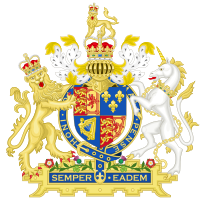
















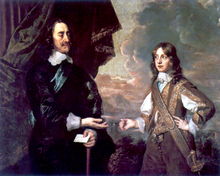
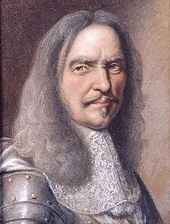

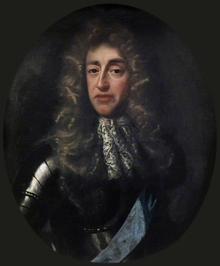
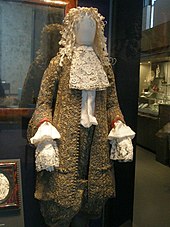

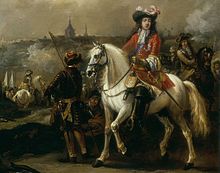

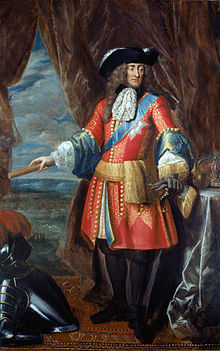

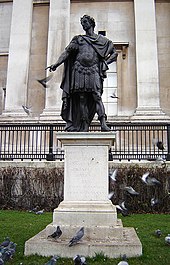
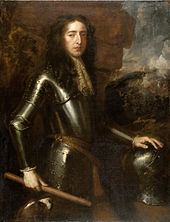
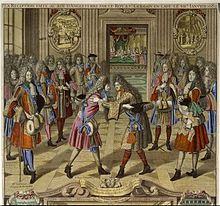



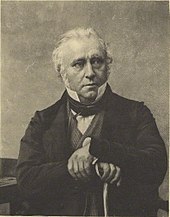



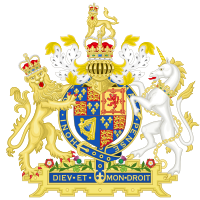
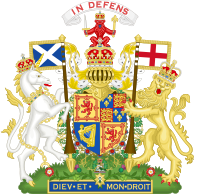
No comments:
Post a Comment